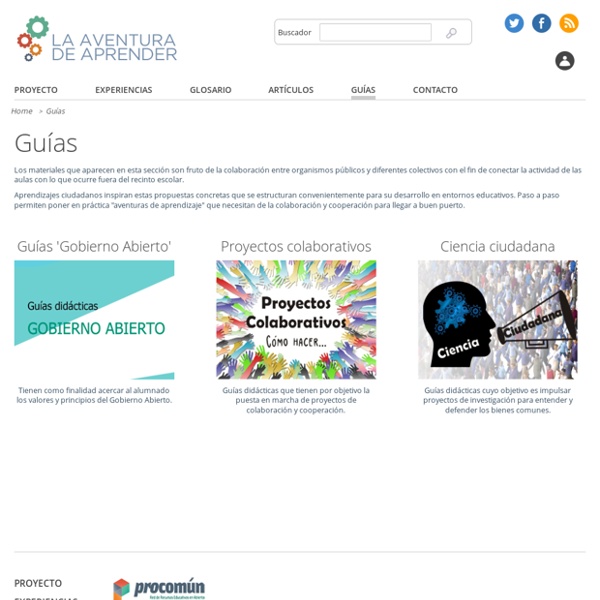



http://laaventuradeaprender.educalab.es/guias
Related: educacion.informacion • Quality • Education in general • ABPProviding Every Student in Your Class With a Voice I was the quiet student who always sought out the back row. I never willingly participated in class discussions, not because I didn't have anything to contribute, but because I preferred to communicate my thoughts in writing. Many of our students sit in class quietly as their peers dominate the discussions, wishing they could add to the conversation. Is this Japanese concept the secret to a long, happy, meaningful life? What’s your reason for getting up in the morning? Just trying to answer such a big question might make you want to crawl back into bed. If it does, the Japanese concept of ikigai could help. Originating from a country with one of the world's oldest populations, the idea is becoming popular outside of Japan as a way to live longer and better.
Effective Questioning Strategies To help students develop skills of inquiry that will go beyond what they do in the classroom, then you must improve the way you question your students. Questions are the foundation of teaching. A good question asked by you, the teacher, can make a huge impact on your students' educational success. If you are looking to improve your effectiveness of teaching, then start with these five strategies to stimulate learning in your classroom. "Doing a Project" vs. Project Based Learning In Project Based Learning, the project itself is used to teach rigorous academic content and success skills. Students work to answer an important question—such as “How can we impact hunger in our community?” By exploring the question over a couple weeks or longer, students become immersed in it, pursuing answers from various angles. Through this process, they apply what they’re learning in meaningful ways.
19 Classroom Management Anchor Charts Whether you’re getting ready for back-to-school time or you need enforce a few more rules in your classroom, classroom management anchor charts can be a great solution. We pulled together our favorite charts on classroom rules, procedures, expectations and more, along with a few of our own emoji designs. Don’t forget to watch the emoji video at the end to see how we put them together! Capital - Ikigai: A Japanese concept to improve work and life For Japanese workers in big cities, a typical work day begins with a state called sushi-zume, a term which likens commuters squeezed into a crowded train car to tightly packed grains of rice in sushi. Essentially, ikigai is the reason why you get up in the morning The stress doesn’t stop there. The country’s notorious work culture ensures most people put in long hours at the office, governed by strict hierarchical rules. Overwork is not uncommon and the last trains home on weekdays around midnight are filled with people in suits. How do they manage?
A Billion People Practicing Emotional Intelligence: The EQ Network Vision Founded in 1997, Six Seconds is the first and largest organization 100% dedicated to the development of emotional intelligence. We research and teach the skills of emotional intelligence to enable individuals, teams, organizations, families, schools and communities to flourish. Six Seconds provides certification courses to train coaches, educators, and leaders in the use of Six Seconds’ original, evidence-based tools. These include individual and organizational assessments, case studies, and publications.
Google's "Be Internet Awesome" Curriculum is Now Available in Spanish At about this time last year Google introduced Be Internet Awesome. Be Internet Awesome offers an interactive site called Interland. Interland is a game in which students navigate a virtual world by correctly answering questions about internet safety. 7Ps Framework “In preparing for battle I have always found that plans are useless, but planning is indispensable.” —Dwight D. Eisenhower Moving towards a learner-centred approach in the bilingual primary classroom – WHAT I BROUGHT BACK FROM CHICHESTER 1.1 Krashen: the affective language barrier on second language acquisition 1.2 What is a learner centred approach? 2.1 Building a good relationship with you students will positively impact their learning
Repository Design activities Co-designing Envisioning Developing as a CLIL practitioner When exploring career options with CELTA trainees here in India, I find that there’s understandably some apprehension in response to the question ‘what next?’ The range of options available is considerably more limited than other countries. It’s technically illegal to employ a teacher who doesn’t have a Bachelor of Education, which essentially locks trainees out of the formal K12 education sector. However with the rise of English as a Medium of Instruction (EMI) across South Asia and the exponential growth in private EMI schools who often have questionable standards, there’s immense untapped opportunity here for CLIL. Content and Language Integrated Learning (CLIL) “is a dual focused educational approach in which an additional language is used for the learning and teaching of both content and language.